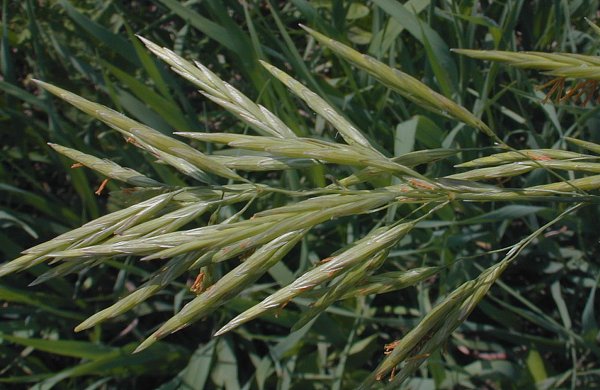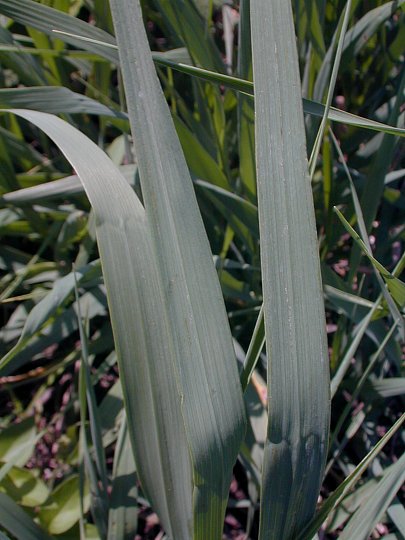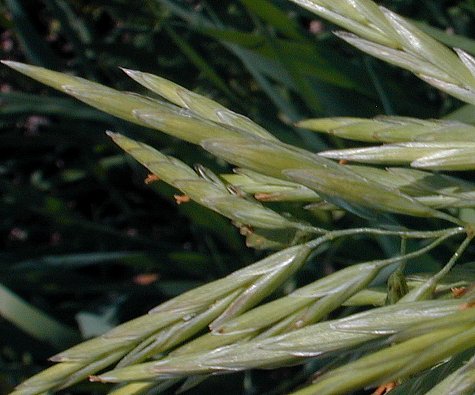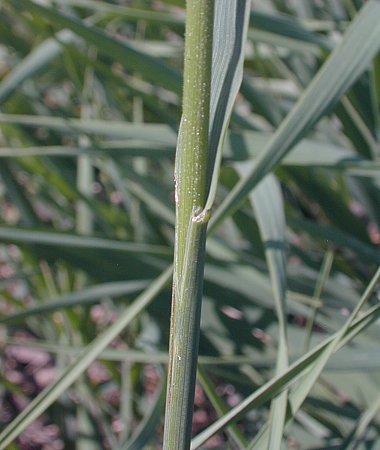Description: This perennial grass is 2¼–3½' tall and usually unbranched. The culms are light green, hairless or short-pubescent, and terete. The blades of alternate leaves are up to 12" long and 16 mm. (2/3") across; they are greyish blue on the upper side, green on the lower side, hairless, and flat. The leaf blades are ascending to spreading and rather floppy in habit. The leaf sheaths are greyish blue, hairless, and closed, although they usually split open near the ligules. Each culm terminates in a panicle of floral spikelets about 4-8" long; the entire panicle has a tendency to lean sideways or droop from the weight of the spikelets. The branchlets of this panicle are ascending to spreading during the period of bloom, otherwise they are more erect and contracted. The branchlets occur in whorls along the central stalk of the inflorescence, and they often divide into secondary branchlets. These branchlets are green, hairless, and somewhat wiry. Each elongated spikelet is about ¾–1¼" (2-3 cm.) in length; it consists of a pair of glumes and 5-10 fertile lemmas that are arranged in 2 overlapping ranks.

During the period of bloom, the spikelets are whitish green, sometimes with purplish or reddish tints. The glumes are about 5-7 mm. in length; they are elliptic-lanceolate, convex to slightly keeled along their outer surfaces, hairless, and shorter than the lemmas. The individual lemmas are about 8-12 mm. in length; they are elliptic-lanceolate, convex along their outer surfaces, hairless, and usually awnless. On rare occasions, some plants may have lemmas with awns up to 2 mm. in length. The outer surface of each lemma has several longitudinal veins. The blooming period occurs during early to mid-summer. Shortly afterwards, the spikelets and culms become light tan. Disarticulation of the spikelets is above the glumes. The elongated grains are about 8 mm. long and light tan or brown. The root system is fibrous and rhizomatous. Dense clonal colonies of plants are often formed from the rhizomes.

Cultivation:
This
robust grass prefers mesic conditions, full or partial sun, and a
fertile loam or clay-loam. It can spread aggressively.
Range & Habitat:
Smooth Brome is a common grass that occurs in every county of Illinois
(see Distribution
Map).
It was introduced as a pasture or forage grass from Eurasia. Habitats
include railroad prairies, woodland edges, savannas, pastures, fallow
fields, grassy areas along roads, weedy meadows, little-mowed areas of
city parks, and waste areas. Smooth Brome has the capacity to
invade native prairies and savannas to a greater extent than other
Brome grasses (Bromus
spp.)
from Eurasia. If anything, its population within the state continues to
increase. This grass is found primarily in degraded natural areas and
habitats with a history of human-related disturbance, where it can form
dense colonies that exclude other plant species.

Faunal Associations: Insects that feed on Smooth Brome (Bromus inermis) and other brome grasses (Bromus spp.) include Oulema melanopus (Cereal Leaf Beetle), Capsus cinctus (a plant bug), Cosmopepla lintneriana (Twice-stabbed Stink Bug), Athysanus argentarius (Silver Leafhopper) and Endria inimica (Painted Leafhopper), Cryptaphis bromi and other aphids, Dissosteira carolina (Carolina Grasshopper) and other grasshoppers, larvae of Cerodontha dorsalis (Grass Sheath Miner), stem-boring larvae of Cephus cinctus (Grass-stem Sawfly), stem-boring larvae of Tetramesa bromicola (a Eurytomid wasp), and larvae of such moths as Leucania multilinea (Many-lined Wainscot) and Ctenucha virginica (Virginia Ctenucha). For a more complete list of these insect feeders, see the Insect Table. The seeds of brome grasses are attractive to upland gamebirds, sparrows, and small rodents, including the House Mouse and White-footed Mouse (Martin et al., 1951/1961; Whitaker, 1966). Young shoots of such grasses are eaten by Canada Geese and hoofed mammalian herbivores, including elk, deer, and livestock; these shoots are also eaten by the Meadow Vole and Prairie Vole (Bellrose, 1942/1976; Martin et al., 1951/1961; Lindroth & Batzli, 1984; Cole & Batzli, 1979). Unlike other brome grasses, the spikelets of Smooth Brome usually lack awns that can injure the mouth parts and gastrointestinal tract of hoofed mammalian herbivores. Dense colonies of Smooth Brome provide cover for small rodents, snakes, and other kinds of wildlife.

Photographic
Location:
A grassy area near the lake at Kaufman Park in Champaign, Illinois.
Comments:
The majority of brome grasses (Bromus spp.)
have been introduced from Eurasia (either deliberately or
accidentally). Many of these species are weedy and aggressive, and
Smooth Brome (Bromus
inermis) is no exception. It can be distinguished from
other brome
grasses by the absence of awns on its spikelets (rarely with awns up to
2 mm. long); almost all other brome grasses in Illinois have spikelets
with conspicuous awns (greater than 2 mm. long). An exception is Rescue
Grass (Bromus
catharticus), which has been collected only
once in Champaign County, Illinois. Rescue Grass is occasionally
planted in the southern states as a source of winter forage. It is an
annual grass with leaf blades up to ¼" (6 mm.) across. In contrast,
Smooth Brome is a perennial grass with leaf blades greater than ¼" (6
mm.) across. Another common name of Bromus inermis
is Hungarian Brome.